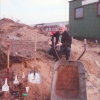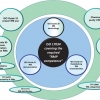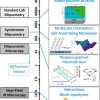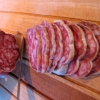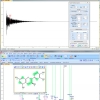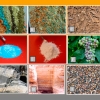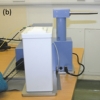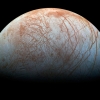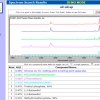Mark Tobin and colleagues describe “Fourier transform infrared spectroscopy and imaging of dragonfly, damselfly and cicada wing membranes”. Insects and plants have evolved highly specialised surfaces such as being highly water repellent or superhydrophobic, which also confers self cleaning properties. This is of interest to materials scientists to help in the development of manufactured materials with similar properties. High spatial resolution FT-IR spectroscopy and imaging provide useful information about the complex chemical patterning that contributes to this functionality.
Articles and Columns
Pages
Kim Esbensen and Claas Wagner have gold on their minds. However, only to explain that “Sampling—is not gambling!”: the American “Gold Rush” of the late 19th Century is a good metaphor for the unrepresentative nature of grab sampling: something that you will soon realise is to be avoided in any sampling regime.
John Hammond updates us on “Reference materials: what’s new?”. The 2015 meeting of the ISO Committee on Reference Materials (ISO/REMCO) was held in June and significant developments in a number of standards that will ultimately affect all users of reference materials have taken place.
In the Quality Matters Column, Peter Jenks reminds us about “BERM 14: it’s that time again!”. The latest in this line of conferences on Biological and Environmental Reference Materials is being held in the USA in October 2015.
Tony Davies, Peter Lampen, Stephen Heller and Evan Bolton report on the future of the spectroscopic data collected as part of the EuroSpec programme. Its long-term preservation is being guaranteed through the PubChem Project of the US National Library of Medicine.
The authors describe “Infrared mapping spectroscopic ellipsometry”. Recent developments in fundamental and materials research have increased the value of mapping techniques such as ellipsometry. IR ellipsometry, since it operates in the mid-IR fingerprint region, provides complementary information on composition, structural properties and interactions
In situ spectroscopic methods such as infrared, Raman and UV/vis spectroscopy are powerful tools to gain insight into reaction mechanisms and catalyst actions in homogeneously catalysed reactions. These methods and combinations of them offer great potential for the real-time monitoring of reactions in the liquid phase, for mechanistic studies as well as process control and kinetics.
Kim Esbensen and Claas Wagner continue their study of “Heterogeneity—the root of all evil” in the Sampling Column. We would be most interested to hear readers’ views on our new column. Representative sampling is essential for most analyses to be relevant, and the column will move from its early theoretical introduction to practical solutions. Readers interested in learning more about the Theory of Sampling may be interested in the Proceedings of the 7th World Conference on Sampling and Blending which are now freely available at http://www.impublications.com/wcsb7.
Research is under way as to the possibility of using high-precision isotopic analysis of metals in a biomedical context. The goal is to develop methods for medical diagnosis on the basis of isotopic analysis of mineral elements in biofluids, for diseases that can otherwise only be established at a later stage or via a more invasive method (e.g., a biopsy) and/or for prognosis purposes. Whilst this work is in a very early stage, it is known that various diseases have an influence on the uptake, metabolism and/or excretion of essential mineral elements and thus, can cause a difference in their isotopic composition in biofluids.
Tony Davies and Mohan Cashyap are concerned about your NMR data. When an article starts “On 10 October 2014 the impossible happened”, you will want to take note! Following the withdrawal of Agilent from the NMR business, Tony and Mohan consider three solutions to ensuring your NMR data is available now and into the future. If you have an NMR of any make, you will want to read this. Do remember that you can comment on the web version of the article.
In the new Sampling Column, Kim Esbensen and Claas Wagner tell us about hetergeneity and why it is everywhere and should always be considered when sampling. The next issue will see a second part looking at how to avoid the errors involved in sampling heterogeneous materials—and that is all of them!
“In vivo Raman spectroscopy of skin” is Paul Pudney’s topic. The skin is a most important part of our bodies. There is great interest in studying it to help understand the many skin diseases we are prone to, including cancer, to develop skin care products and, increasingly, as an alternative route to administer pharmaceuticals instead of through the gut. Raman spectroscopy is an excellent tool to study these, and has particular advantages in its ability to do so in vivo.
Christian Schröder tells us about “Mössbauer spectroscopy in astrobiology”. Iron is abundant in the Earth’s crust, as well as on Mars and is likely to be so also on Jupiter’s moon, Europa. Iron is important for life and may have played a role in the origin of life as an energy source and by providing mineral surfaces as a template for surface metabolism. Iron continues to be essential for almost all organisms as the functional centre of many proteins and enzymes. Mössbauer spectroscopy is a powerful tool to study iron-bearing solid substances and as such has applications in the search for life in other parts of our Solar System.
Sampling on important works of art is not possible and this is the main reason why only non-invasive techniques, such as MSI, are becoming increasingly popular to assist with undertaking conservation decisions.
Further introduction to the Theory of Sampling by Kim Esbensen and Claas Wagner
Yvonne Fors, Håkan Grudd, Anders Rindby and Lennart Bornmalm tell us about “X-ray fluorescence for cultural heritage: scanning biochemical fingerprints in archaeological shipwrecks”. Two outstanding examples of the preservation of wood are the warships Vasa, in Stockholm and the Mary Rose in Portsmouth and this article looks at the role XRF has played in the preservation of the wood of both ships.
The “Application of Raman and photoluminescence spectroscopy for identification of uranium minerals in the environment” is described by Eric Faulques, Florian Massuyeau, Nataliya Kalashnyk and Dale Perry. Uranium forms a large number of compounds and complexes, and these are most helpful in the study of uranium, its chemistry and transport in the environment. Raman and photoluminescence spectroscopy provide complementary information and are powerful tools for direct speciation of uranium and identification of natural uranyl minerals relevant to the environment.
Following on from the two recent articles on how the Cloud may be impacting the availability of scientific software delivery for spectroscopists, this article looks at what the wider commercial spectroscopy software providers have been doing in this area.
C. Burgess and J.P. Hammond outline the work that has been undertaken to modernise the spectroscopic General Chapters in the United States Pharmacopeia (USP).
“Optical spectroscopy in therapy response monitoring: an awakening giant” by Arja Kullaa, Surya Singh, Jopi Mikkonen and Arto Koistinen looks at the important advances made by optical spectroscopy techniques, such as diffuse optical spectroscopic imaging (DOSI), Raman, diffuse reflectance and fluorescence spectroscopy, in changing how cancer is managed in patients. The ability to repeatedly monitor tumour dynamics to see how effective a particular treatment has been has enormous potential for us all.


